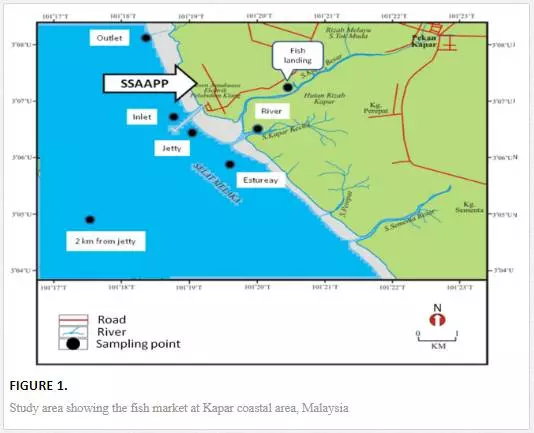Investigation of Po-210 and Heavy Metal Concentration in Seafood Due to Coal Burning – Case Study in Malaysia
Assessment of radioactive elements in the natural environment and their effects on living organisms has been one of the most important issues in radioecology and radiological protection in recent years. The bioaccumulation of Po-210 refers to a process by which Po-210 accumulates in various tissues of a living organism. Po-210 is a high-energy alpha particle emitter in the uranium decay chain [1] and among natural radionuclides occurring in the ocean, alpha emitters are considered to be the most important [2], because of their high mass and charge, are more damaging and so are accorded a “radiation weighting factor” of 20. Moreover, Moroz and Parfenov [3] described that Po-210 can have a toxic effect even in small concentrations due to its high-energy alpha radiation. Despite its toxic properties, the radionuclide Po-210 is readily assimilated by marine primary producers [4] and is known as a major contributor (90%) of the natural radiation dose from alpha-emitting radionuclides, as received by most marine organisms [1, 5].
Po-210 enters the marine environment mainly through the global fallout of aerosols and gases, through release from the earth’s crustal material, through substances released due to activities related to the processing of uranium ore and as a by-product of fertilizers and oil industries. After Po-210 enters the marine environment, they are subjected to different biogeochemical reactions (e.g., dissolution, hydrolysis, complexation, sorption/desorption, coprecipitation, speciation) [6], which depends upon their chemical form and the characteristics of the marine environment [6]. According to Stewart et al. [7], Po-210 displays very strong binding to particle surfaces, including organisms. Moreover, Po-210 is primarily associated with proteins in living organisms and can also penetrate into the cytoplasm of cells [8]. Because of that, Po-210 can effectively assimilate in higher marine organisms. In addition, radionuclides present in the marine environment can be transferred through plankton to higher organisms such as fish and mussels, which are well-known filtration organisms. Therefore, their concentration is increased through the trophic chain with the highest values found in predators [6]. The Po-210 accumulated in marine organisms is generally derived from the food chain [9], and significant differences are noted in its accumulation in different species. Very high levels of Po-210 have been observed in certain organs of marine species such as the digestive tract of fishes, the digestive gland of mollusks and the hepatopancreas of crustaceans; these levels are generally 1–2 orders of magnitude higher than those found in the muscle of these species [10–12].
Similarly, large amount of heavy metals can be deposited in the aquatic system near the coal-burning power plant area as the smallest particles of fly ash are enriched with heavy metals [13] and hold ecological importance because of their toxicity, persistence and bio-accumulation. As a result, there has been growing interest in determining the heavy metals levels in marine environment and attention was drawn to the measurement of contamination levels in public food supplies, particularly fish [14–16]. Additionally, heavy metal concentrations in aquatic organisms along with bio-concentration have been extensively studied in various places around the world [17–24]. Generally, heavy metals are defined as metallic chemical elements that haverelatively high density and are toxic or poisonous at low concentrations [25]. In marine environment, heavy metals are potentially accumulated in sediments and marine organisms and subsequently transferred to man via the food chain as described by Pourang et al. [26] and thereby it poses the threat to human health. There are three possible routes by which metal can be derived, namely, (1) from solution, (2) from ingestion of food, and (3) from the ingestion of particulate matter containing metals [27]. Moreover, direct uptake from the sediment particles can be an important additional source of sediment-bound contaminations for sediment-feeding organisms [28].Although there have been many studies on chemical contamination in marine organisms [29–33], sufficient data are not available for different marine species of the coal-burning power plant area. Therefore, the aim of this work was to investigate the level of Po-210 and heavy metal in marine organisms from the coastal area of Kapar and to compare with the other places of the world.
STUDY AREA
Malaysia, which is located between 2ş and 7ş north of the Equator, has a tropical climate with warm weather all the year round with temperatures ranging from 21şC to 32şC. Malaysia has about 4,800 km of coastline comprising two distinctly different physical formations, namely the mangrove fringed mud flats and sandy beaches. The Malaysian coastal area includes a land mass totaling approximately 4,162 square kilometers (sq.km), and an EEZ totaling approximately 465,700 sq. km. These areas are endowed with a rich diversity of living and non-living resources which have significant effects on the country’s economic growth as well as her environmental well being and social order. The study was conducted at Kapar coastal area, which is very adjacent to Sultan Salahuddin Abdul Aziz power station. This power station is located at the western coast line of west Malaysia, at the Malacca strait, normally known as the largest power station in Malaysia with generating capacity of 2,420 MW and contributes about 23% of the country’s energy demand. This power station is the first power station with triple fuel firing capability (gas, oil and coal) in Malaysia. The power plant applies seawater as the source for cooling water and the sea is used as the pathway for transporting coal. On the other hand, the surrounding coastal area is the ultimate recipient of the fly ash which is produced by coal burning. As a result, this area is becoming important for radiochemical analysis and has been preferred for this present study.
Materials and methods
Samples of seafood (Table1) popular with the Malaysian population were collected from the local fish market which is very near to Sultan Salauddin Abdul Aziz power plant (Figure1). The seafood types were divided into three groups which are: fish (Arius maculatus), crustacean (Penaeus merguiensis), and molluscs (Anadara granosa). The organism samples were transported to the laboratory for further analysis and kept in freezer.

In the laboratory, the total length (cm) of fish samples was taken from the tip of the snout to the extended tip of the caudal fin. In case of shrimp, the distance from the tip of the rostrum to the end of telson has been considered as the total length. For cockle valve length was measured by using a vernier caliper to the nearest 0.1 mm. The total weight (g) of each sample was measured using a top loading electronic balance.
For the preparation of samples, only edible parts were selected. The soft tissues and muscles from the shells and bones have been separated from molluscs, crustaceans and fishes. The wet weights of the samples have been recorded and then dried in an oven at 60°C overnight to obtain the dry weights. After drying, mass of the dried samples was determined and the fresh weight to dry weight ratio has been calculated. Then, the samples were homogenized with a mortar. Finally, the samples were wrapped with aluminum foil and preserved in leveled plastic bag for radiochemical analysis.The radiochemical separation method was used to estimate Po-210 in the samples [2, 34]. About 0.5 g of the dried sample was taken and Po-209 of a known activity was added as a yield tracer. Then the samples were digested with nitric acid and perchloric acid. The solution was filtered and gently evaporated to dryness. Then the samples were dissolved in 50 ml of 0.5 M HCl along with a pinch of ascorbic acid to reduce Fe (III) and Po-210 was spontaneously deposited on brightly polished silver discs (2 cm diameter) for a period of 3–4 h at a temperature of 70–90şC.
Three replicates of organisms sample were analyzed for the measurement of heavy metals such as Cu, Cd, Zn, Pb and Cr, and all the glass wares used for analysis were acid-washed to avoid the possible contamination. About 0.3–0.5 g of dried samples for each replicate were weighted in a beaker using electronic scales. The samples were then digested with a mixture of 30 ml nitric acid (HNO3, GR, 65%, Merck) and 5 ml of concentrated perchloric acid (HClO4;GF; 70%, Merck). After that, 10 ml of concentrated hydrochloric acid (HCl, GR; 37%, Merck) was added in the samples and heated until dryness. After cooling the sample, 2.5 ml of nitric acid was added into the samples. A total of 20 ml of de-ionized distilled water was added into the beaker containing the sample and filtered through filter paper (Whatman, GF/C; diameter 47 mm; pore size 0.45 µm). After that, the filtered solutions were added with de-ionized distilled water until 70 ml to make it to 0.5M HNO3. Determination of heavy metals was carried out using the inductively coupled plasma mass spectrometry (ICP-MS) (Perkin Elmer-Elan 9000).
Results and discussions
Arius maculatus collected in this study ranged in size from 10 to 35 cm in total length and 112 to 296 g in total weight. Po-210 concentration in the soft tissue of collected fish samples ranged from 0.17 to 11.86 Bqkg-1 (dry weight) with the mean concentration value of 5.42 Bqkg-1 (dry weight) (Figure 2). However, the calculated result of the present study has been compared with other reported values of different places. This comparison showed wide variation because where measurements have been made in a wide variety of fish species, consistent interfamily variabilities in Po-210 concentrations are found, and there is strong evidence that the Clupeidae and Scombridae families have significantly higher Po-210 levels than other fish families [35]. Moreover, where bony teleost fish have been compared with cartilaginous elasmobranchs from different oceanic regimes and depths, Po-210 concentrations in the tissues of elasmobranchs are generally lower than in those of teleosts, with the difference between the two taxonomic groups being greater in liver and gonad tissue than in muscle [30, 36]. Similarly, Štrok, and Smodiš [8] described that differences between two fish species can be observed, probably due to their diverse feeding habits. The same results were found in IAEA [37], where the specific activities for pelagic species, such as S. pilchardus, were larger than for benthic species (M. cephalus).
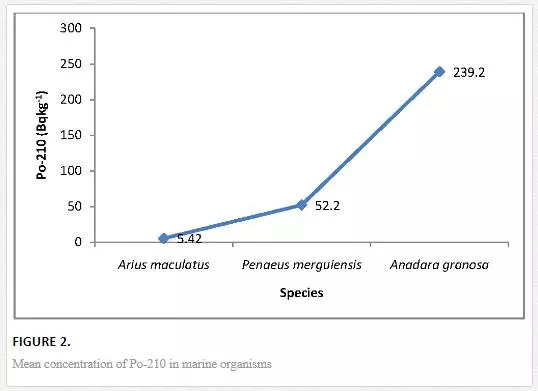
However, investigations on Po-210 accumulation by fish have thus far shown that the average concentration ranges from 2.6 to 259.0 Bqkg-1 [35, 38–42] which is supporting the result of the present study. Po-210 concentration in the present study is within the range of the values reported for Japan, Poland, Sudan, Brazil, England and Baltic Sea. A comparatively higher level of Po-210 concentration was observed in India because of the impact of a nuclear power station which operates at Kalpakkam. In the case of Cuba, the elevated amount of Po-210 activities was characterised by global fallout. Similarly, very high values of Po-210 were observed in the USA and Australia. However, the calculated value ranged within the global average value.
The analysed shrimp (Penaeus merguiensis) samples varied between 5 to 18 cm in total length and 2 to 15 g in total weight. The Po-210 activity ranged from 16.81±0.75 to 108.02±4.82 Bqkg-1.The total length of collected cockles (Anadara granosa) ranged from 2.10 to 4.30 cm whereas the total weight varied between 5 to 19 g. Expressing radiometric data in terms of dry weight, the concentration of Po-210 in the soft part of cockle ranged between 47.20±2.11 and 725.90±32.39 Bqkg-1 with the mean value of 239.20±163.24 Bqkg-1. In the present study, the Po-210 concentration in shrimp is comparable with the values reported for North Atlantic, Baltic Sea and global average value [43–46]. Much higher values were observed for different places of India which might be the impact of nuclear power station [47–50].The concentration of heavy metals in analysed organisms is presented in Figures 3, 4, 5, 6 and 7. Anadara granosa (1.47 ±0.55 μgg-1 dry wt) had the highest concentration of cadmium, followed by Arius maculatus (0.22±0.08 μgg-1dry wt) and Penaeus merguiensis (0.17±0.10 μgg-1dry wt). In living organisms, copper is considered to be highly toxic, and ranks among the more toxic heavy metals to fish. However, the mean copper concentration was highest in Penaeus merguiensis (21.57± 7.78 µg/g dry wt), followed by Anadara granosa (6.11±4.20 μgg-1dry wt) and Arius maculatus (2.01± 0.57 μgg-1dry wt). In this study, Anadara granosa had the zinc concentration of 93.31± 12.56 µgg-1 dry wt, which was higher than that found in Arius maculatus (69.80±20.18 µgg-1 dry wt) and Penaeus merguiensis (76.40±9.94 µgg-1 dry wt). The higher concentration of lead in fish is probably because of the food source. Comparatively lower lead concentrations were observed in molluscs and crustaceans. Chromium is only moderately toxic to aquatic organisms and in the present study the filter feeding species Anadara granosa had the highest concentration of chromium (1.45± 1.14 µgg-1 dry wt), flowed by Arius maculatus (0.79±0.26 µgg-1 dry wt) and Penaeus merguiensis (0.53±0.04 µgg-1 dry wt).
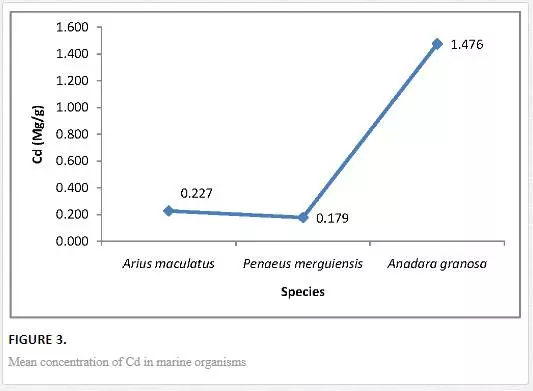
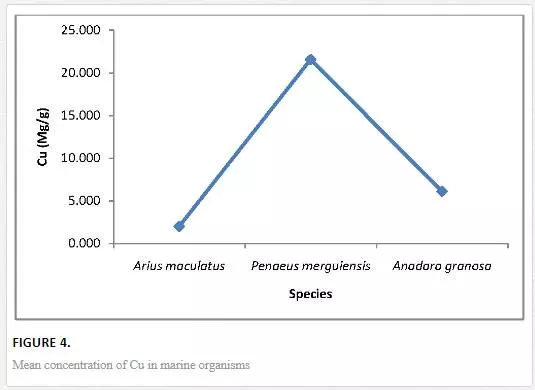
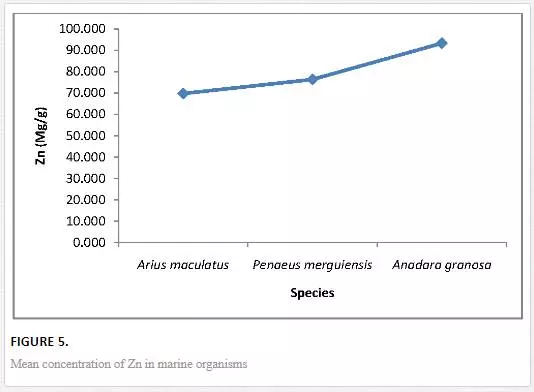
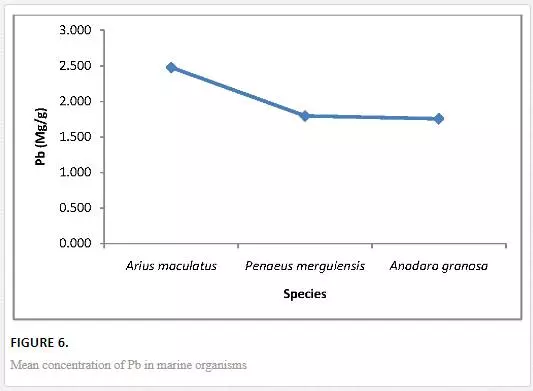
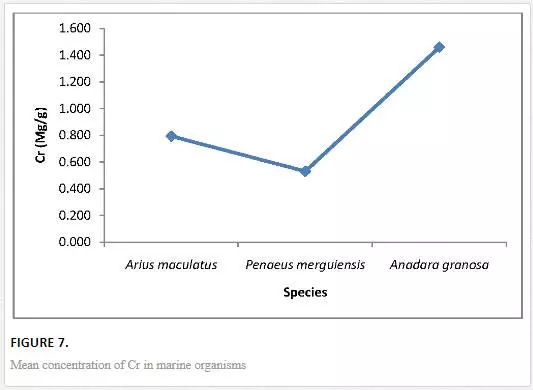
Heavy metal concentrations measured in organisms are compared with the reported values of other places and the guideline (Table2). None of the species analysed in this study was found to contain cadmium concentration above the proposed permitted concentration and the values were within the range of other reported values. The calculated values of copper are within the range of previous studies and lower than the guidelines. Zinc concentration in fish is comparatively higher than other reported values but within the range in case of the values reported for Malaysia. However, this value is lower than the safety levels. For crustaceans, comparatively higher value is observed in case of Malaysia, but it is still lower than the safety guideline. On the other hand, in case of molluscs, the measured value was higher than the other reported values but lower than the safety limit which is stated for Malaysian population. Thus, zinc consumption of organisms from Kapar coastal area poses no threat to human. In case of fish and crustaceans, the lead concentrations are higher compared to other reported values, except the value reported for Malaysia. However, this value is lower than the safety limits. On the other hand, the measured value for molluscs in the present study demonstrated higher values than the literature, but the value did not cross the limit of safety which is declared for Malaysian population. However, our value is lower than the reported value of India. On the other hand, the chromium concentration in molluscs is also within the range of other places. Eisler [51] reported that chromium levels in the edible tissues of uncontaminated marine molluscs usually lie between 0.5 and 3.0 µgg-1. Although there is no deleterious health effect of molluscs, the biologically available Cr(VI) is known to be carcinogenic to man and other elements [52].

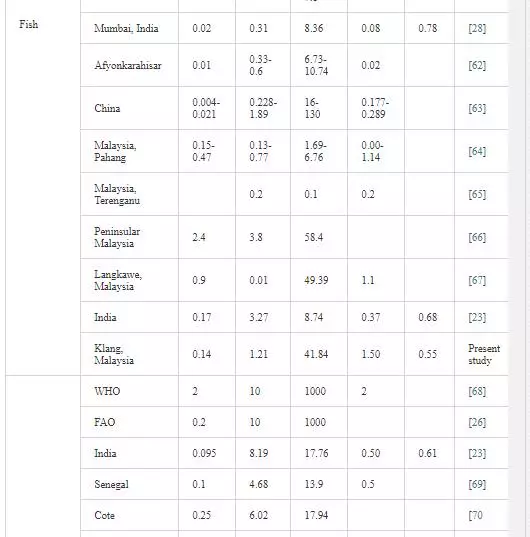

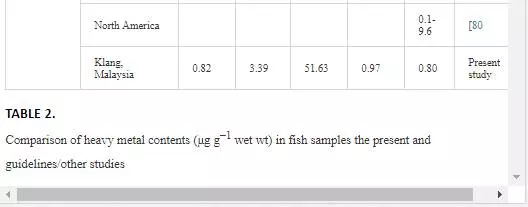
Conclusion
This study provided a general view of chemical contaminants in the Kapar power plant area where the chemicals were non-uniformly distributed with the groups of organisms. The differences in the level of contaminants in different groups of seafood could be due to the differences in metabolism and feeding pattern. In this study the highest contaminants accumulator species, Anadara granosa, is a filter feeder and feeds by straining suspended matter and food particles from the water. Additionally, this species has direct contact with sea sediments and this mode of life may contribute to higher levels of contaminants. On the other hand, the other two species are more mobile and consume food from the water column. Thus, they
demonstrated lower contaminants accumulation pattern.
